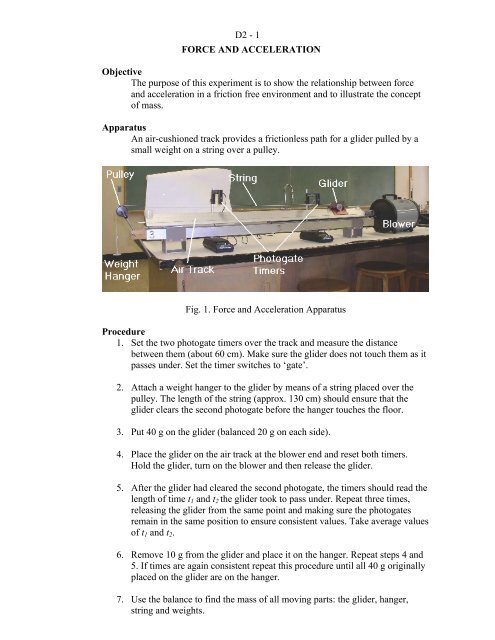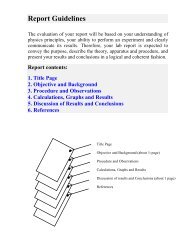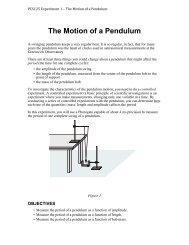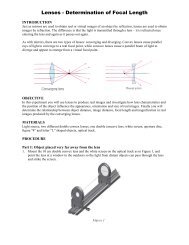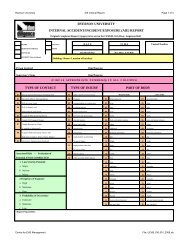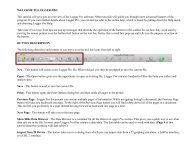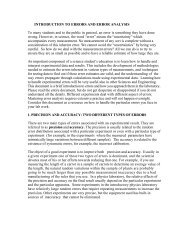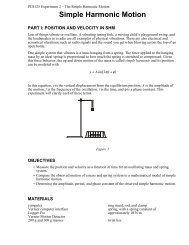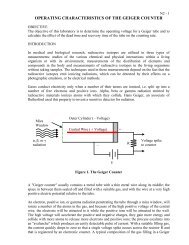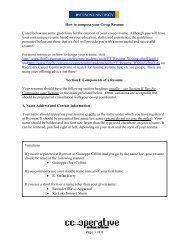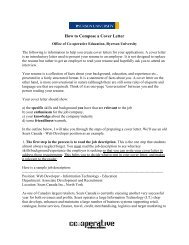Newton's Second Law
Newton's Second Law
Newton's Second Law
Create successful ePaper yourself
Turn your PDF publications into a flip-book with our unique Google optimized e-Paper software.
D2 - 1<br />
FORCE AND ACCELERATION<br />
Objective<br />
The purpose of this experiment is to show the relationship between force<br />
and acceleration in a friction free environment and to illustrate the concept<br />
of mass.<br />
Apparatus<br />
An air-cushioned track provides a frictionless path for a glider pulled by a<br />
small weight on a string over a pulley.<br />
Fig. 1. Force and Acceleration Apparatus<br />
Procedure<br />
1. Set the two photogate timers over the track and measure the distance<br />
between them (about 60 cm). Make sure the glider does not touch them as it<br />
passes under. Set the timer switches to ‘gate’.<br />
2. Attach a weight hanger to the glider by means of a string placed over the<br />
pulley. The length of the string (approx. 130 cm) should ensure that the<br />
glider clears the second photogate before the hanger touches the floor.<br />
3. Put 40 g on the glider (balanced 20 g on each side).<br />
4. Place the glider on the air track at the blower end and reset both timers.<br />
Hold the glider, turn on the blower and then release the glider.<br />
5. After the glider had cleared the second photogate, the timers should read the<br />
length of time t 1 and t 2 the glider took to pass under. Repeat three times,<br />
releasing the glider from the same point and making sure the photogates<br />
remain in the same position to ensure consistent values. Take average values<br />
of t 1 and t 2 .<br />
6. Remove 10 g from the glider and place it on the hanger. Repeat steps 4 and<br />
5. If times are again consistent repeat this procedure until all 40 g originally<br />
placed on the glider are on the hanger.<br />
7. Use the balance to find the mass of all moving parts: the glider, hanger,<br />
string and weights.
D2 - 2<br />
Calculations<br />
We will use<br />
to find the acceleration for each weight where x is the distance between the<br />
photogates. The velocities v 1 and v 2 are found by dividing the length of the<br />
glider l, by the time t 1 and t 2 respectively, taken to pass under the photogate:<br />
and<br />
The force causing acceleration is given by mg where m (expressed in kg) is<br />
the total mass of the hanger and weights placed on it and g is the<br />
acceleration of gravity (9.8 m/s 2 ).<br />
Results<br />
Plot a graph of acceleration (y-axis) versus force (x-axis). Find the slope of<br />
the best straight line through the points. The value of the slope is the<br />
constant of proportionality between acceleration and force. Compare this<br />
value to the reciprocal of the mass of the glider, hanger and the 40 g masses<br />
as obtained on the balance.<br />
Pre-lab Questions<br />
1. What is the objective of this experiment?<br />
2. Define acceleration.<br />
3. Define force.<br />
4. State Newton’s second law.<br />
5. Is Newton’s second law valid if friction is present? Explain.


